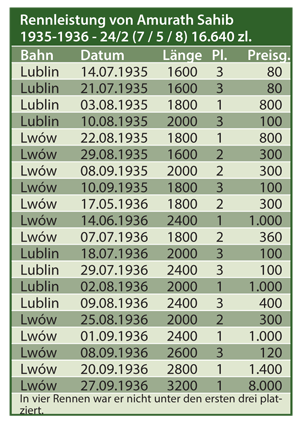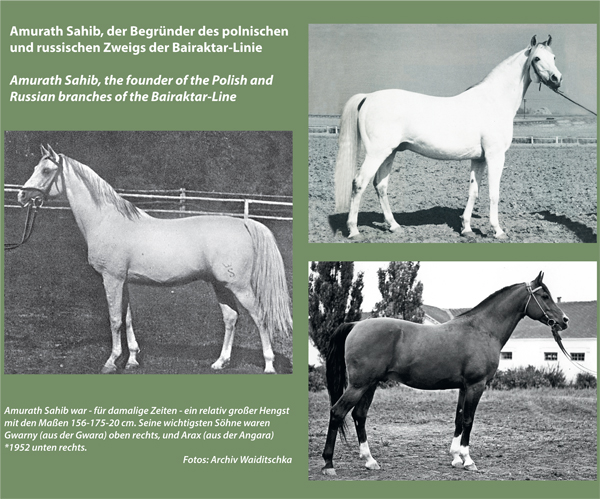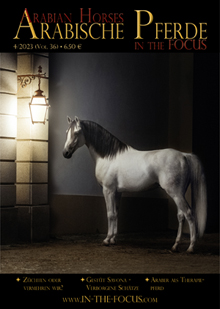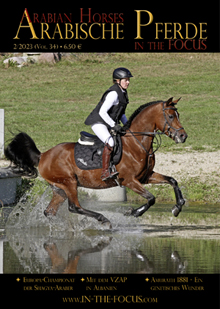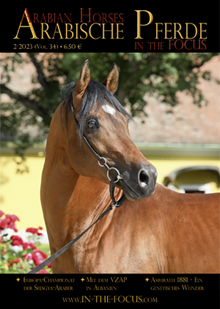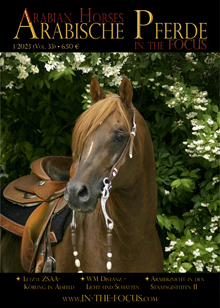You have to look far back in today’s pedigrees to find his name, but he was one of the best representatives of the Bairaktar line and an important link between the Russian and Polish breeding lines: Amurath Sahib, of whom the great breeders and horse people of their time had to say mainly good things, be it Andrzej Krzysztalowicz, Hans Fellgiebel or Dr. Ekkehard Frielinghaus.
Amurath Sahib was born at Teresa Raciborskas Breniow stud, a small but fine private stud near Lwów (Lemberg) in Poland. It was founded in 1919 with the purchase of two mares from Bábolna, Donka (Schechan-Schammar / 80 Koheilan II) *1910 and Mersucha (Mersuch / O’Bajan) *1908, as well as the mare Rusalka (Czorsztyn / Polenta) *1911 from Slawuta. When the first meeting of the private breeders’ association took place in Lemberg in 1927, and with this occasion also the first Arab races after WW I, Teresa Raciborska was there with her mare Sahiba and immediately won the derby. Sahiba not only proved herself on the racetrack, but later also as a broodmare: She produced some good race horses, such as Ibn Nedjari (by Nedjari) *1931 and our protagonist Amurath Sahib (by 35 Amurath II) *1932.
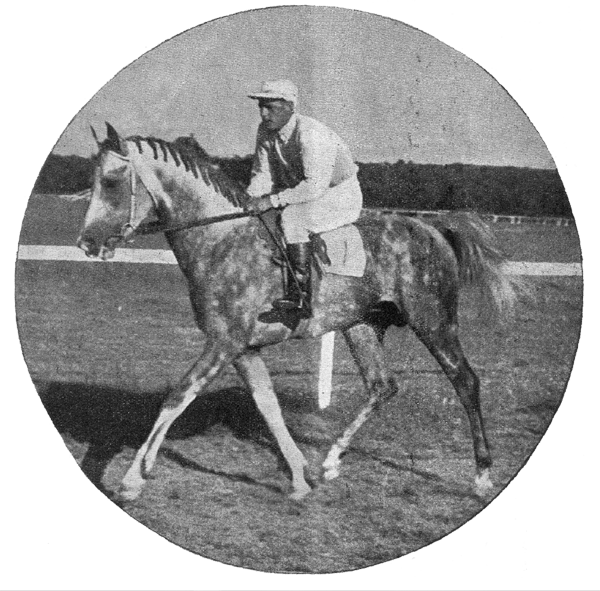
Amurath Sahib, winner of the “Prize of the Ministry of Agriculture” in Lwów 1936.
Foto: Dr. L. Zaturaki,
Jeździec i Hodowca, Jhg. 1936, Nr. 36
But let’s take a closer look at Amurath Sahib’s pedigree: In the grandparents’ generation we find Amurath 1881 “Weil”, the stallion of the century from the breeding of the Royal Private Stud in Weil, who, through his Radautz offspring, has had a lasting influence on the world of the purebred Arabian, but also on sport horse breeding. Much has already been written about him, so we want to keep this brief. In Radautz, he had only few purebred Arabian foals, one of which was out of the original Arabian mare Fatme (in Radautz “186 Fatme”), about whom it says in the Radautz stud book: “Imported through the k.u.k. Rittmeister Wenzel Wolf, she was bought from a gendarmerie officer in Syria for 1,300 francs and stood as a pepiniere mare as of July 17, 1905. Sold to the horse butcher for 80 kroner on October 5th, 1915.“ She is said to have belonged to the Obayan tribe, was born in 1899 and a small, tough, very noble and fine chestnut mare. Of her 9 foals, two stallions stood at stallion depots in Galicia and two daughters became broodmares in Radautz. One of these two state sires was 35 Amurath II, who was stationed in the Sadow-Wisznia Stallion Depot, Galicia, from 1911. He was a light brown stallion about whom W. Wnukowski writes: “Harmoniously built, well connected, with correct hind legs. This stallion is also endowed with a lot of charm, type and nobility, although his movements are not as good as those of 239 Amurath III. His measurements are 152-169-19.5 cm. “
On the maternal side, we also find a stallion from Weil Stud in the grandparents’ generation, Nana Sahib I (Selim / Smyrna) *1907. In April 1910, he was sold to the k.k. Ministry of Agriculture in Vienna for 3500 florins, from where he was transferred to Radautz. In 1911, he was sent to the Sadowa-Wisznia stallion depot and in 1918 to Janow Podlaski. Wnukowski says about him: “Noble, with clearly defined withers, good topline and sweeping movements. Size: 155-176-19.5 cm.“ However, only two privately-bred offspring from him are known to us, one of them is Sahiba, who unfortunately died much too early and only left four foals: Apart from the above mentioned Amurath Sahib and Ibn Nedjari (by Nedjari), it was Sumak (by Kuhailan Haifi), and a daughter Siniora (by Kuhailan Haifi), the latter continued the line for a short time, but was probably lost as a result of the war. Sahiba’s dam is Donka, the founding mare of Teresa Raciborska from Bábolna. In the grandparents’ generation of the “Polish” Amurath Sahib, 50% goes back to the breeding of Weil Stud, 25% to the breeding of the Hungarian state stud Bábolna and 25% to desert blood. Apart from that he is inbred in II. / IV. generation to Amurath 1881 Weil. It is a fortunate coincidence in history that the Polish private breeders resorted to these horses, because ultimately Amurath Sahib or his father 35 Amurath II is the genetic bottleneck through which the Bairaktar line had to go before it could flourish again to world fame.
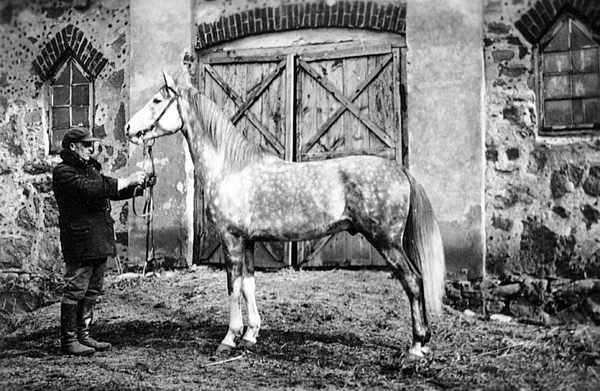
A rare photograph of Amurath Sahib as a young stallion.
photo: Archiv A. Mikulska
On the racetrack
At the age of three, his breeder sent Amurath Sahib to the racetrack. At the end of the season he was 10th out of 40 horses that ran in the racing season of 1935 (based on earnings). At the age of 4 he got into the right shape when he won the “Prize of the Minister of Agriculture” in Lwów over 3200 m, which brought him to third place in 1936 among the most profitable Arabian race horses. As the winner of this race, he was bought by the state and first transferred to the Boguslawice stallion depot and then to Janow Podlaski in 1943. Here Andrzej Krzysztalowicz met him, who remembered him as follows: “Amurath Sahib was a relatively tall stallion with more caliber than Witraz and considerably more than Wielki Szlem. He had a good frame, a long neck and a not too noble head, but with expressive eyes, good movements and a straight profile. His legs weren’t all that dry, with feathers, but they were of strong bones and correct. As a horse with good, but not extraordinary movements, he was very good under the saddle, although he had problems when fastening the girth. Due to his size, he was also used in Partbred breeding and even the Germans liked to ride him. He was quite good at obstacle races like the St. Hubertus hunt. “
Ignacy Jawarowski, director of the Michalow stud, recalled Amurath Sahib as follows: “Amurath Sahib was a grey horse with a dry, expressive, medium-sized head, long neck and a perfect topline and horizontal croup, which he often passed on to his offspring. He had correct feet and legs, masculine expression and good movements, albeit a bit narrow in the chest. His foals inherited his frame, but sometimes lacked the type and dryness, and were a little too long in the loin. Nonetheless, his daughters were exceptionally good broodmares.“
Dr. Ekkehard Frielinghaus, who worked as a veterinarian in Janow Podlaski during the German occupation, said of Amurath Sahib: “In the opinion of many experts, it was very unlikely that Amurath Sahib would become a chief sire in a Polish state stud, for three reasons: He was born in a private stud, he had a “non-Polish” pedigree, and he represented the Saklawi type, whereas in Poland the Kuhailan type was preferred. Nevertheless, Gustav Rau, who knew the Weil stud bloodlines very well, decided to try him in Janow Podlaski. Amurath Sahib had many merits in terms of conformation, movement, good temperament and stamina. When he came to Janow in 1943, I was thrilled when I rode him for the first time – he was simply born to be a riding horse!”
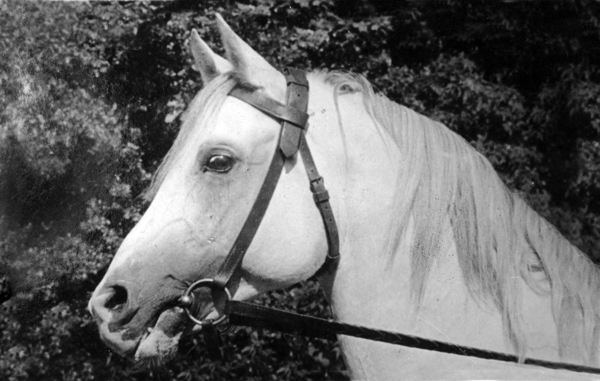
A rare portrait of Amurath Sahib, showing his straight profile, his small ears, the strong jaw and large nostrils. The eye is rather small.
photo: Archiv A. Mikulska
In 1939 Hans Fellgiebel was appointed to Janow Podlaski by Gustav Rau, who was now the chief director and representative for horse breeding and stud farms in the occupied Polish territories, where in 1940 he took over the management. The arrival and influence of Amurath Sahib thus fell into his service time and so Hans Fellgiebel should have a detailed say (from his typewritten manuscript “The Polish Arabian State Stud Janow Podlaski 1919-1946”):
“In 1943 the stud was assigned the two stallions Amurath Sahib ox and Kastor (Arabian Partbred) as chief sires. The 1944 foal crop was the best in terms of numbers and quality. This improvement in quality is mainly thanks to the excellent sire Amurath Sahib. Amurath Sahib was a relatively tall stallion with long lines that lacked a little depth. Still, all of his foals were deep enough. He had an exemplary topline, and what was striking about him was his faultless feet and legs with particularly good hocks, and his floating, ground covering, correct movements. The noble, small head was carried by a beautifully shaped, mighty long neck. The whole horse was of great beauty and harmony. The hereditary strength of the stallion is one of the unique features. I would like to call him the “Dampfroß of Arab breeding” [with reference to the Trakehner stallion Dampfroß]. He was an all-rounder. One would have easily recognized his foals in the herd without their white leg markings and wide blazes. They had all inherited their father’s beautiful lines and superb legs. He had also given them his wonderful neck and attachment, as well as his good shoulder. In most cases they also had his topline and were consistently deeper than he himself. Amurath Sahib’s foals all had a typical Siglavi head with a straight forehead and large nostrils. Amurath Sahib was the universal main sire who was responsible for all departments. Even the worst mare still produced a usable foal with him. If mares did not bring a reasonable product with other stallions, then they went to Amurath Sahib and the foal was good.
Especially with the Yugoslav mares one achieved the best results with him. His foals by Kaduna, En Nasira IX, Marzouk II, Kadina XX, Lava and Hamdani IX were among the best. Laleczka Ewuni also produced two first class fillies. The Arabian half-blood mare Izyda also brought a delightful, very noble grey filly. Unfortunately this foal had strong muscle atrophy in the hindquarters at the beginning. The daughter of the Arabian half-blood mare Stateczna promised to be a first class horse. That was the first good foal of this excellent mare who only gave bad products with Efendi. The Anglo-Arab half-breed Imatra produced two very strong, large-framed colts and one filly, which unfortunately died of paralysis. The older one, named Edelmarder, was strong and heavy and was one of the best of his year. The other, Felsztyn, who was a year younger, showed an even better quality than his brother. Wilgas colt, born in 1946, was a colt with main stallion quality. In the same year, an even better colt was produced by the Anglo-Arab half-breed Calabria (Proch xx out of Igraszka by 428 Amurath), who should be retired due to typelessness. Her chestnut colt by Amurath Sahib was by far the best foal of the year 1946. Hardly to be surpassed in terms of power, bone strength, frame, correctness, nobility and expression. Even the bad, angular, inharmonious, expressionless Stolnik daughter Christine (out of Wladczyni) produced a first-class Amurath Sahib foal with a lot of expression and considerable bone strength, which promised to be a very good chief sire. The unsightly little Bajeczka left behind a very noble, beautiful filly named Ekbatana, who, although half-blood, was very much in the type of the noblest purebred Arabian. The mating of Efendi daughters with Amurath Sahib was very successful.
In 1946, Circe, Cartagena, Caluga and Cremona all produced flawless foals from him. The best of these was the grey filly out of Circe, in which the enormous depth and breadth of Efendi was combined with the frame and the elegance of Amurath Sahib to a harmonious whole. The first successes in Anglo-Arabian thoroughbred breeding were only brought about by Amurath Sahib. By far the best foals of his were given us by Ugmuza x. Her son Filar x was chosen to be the chief sire at the age of one. He represented the best combination of Arabian and English blood that I have seen so far. If all Anglo-Arab thoroughbred horses were like this grey colt, then their breeding would be justified. Filar x had really only inherited the good from each side. He was a prime example of correctness, dryness, frame, line, harmony, bone strength, nobility and expression. His right sister Galeria x was also very good, but not quite as harmonious as him. Pogon x and Beguinet also produced very good foals. In purebred Arabian breeding, Witraz was preferred despite the three good Amurath Sahib daughters Balalajka, Lala and Amneris. Witraz was probably more difficult to breed, but gave horses in the pure desert type, which was not always the case with the Amurath Sahib children. They were already more cultural Arabians. Nonetheless, Wilga and Pieszczota produced very good foals from him.“

Amurath Sahib (second from right) hacking out in Nettelau, where the Janow horses were evacuated during the Second World War.
photo: Archiv T. Andrzejewskiego
The sire of broodmares
As it already sounds with Fellgiebel, Amurath Sahib was – like many stallions from the Bairaktar line – a “sire of broodmares”. His best products were Lala, Amneris and Balalajka, which were born in private studs during his years at the stallion depots. In particular, Balalajka later set a monument for itself with Bandola and Bask. Then Arwila, Adis Abeba, Darda, Daribba, Estokada, Gwadiana and Epigona from his time as chief sire in Janow Podlaski and later in Klemensow. In particular, Estokada should be mentioned here, who was the founder of the famous E-line at the Michalow stud, which produced horses like Emigracja and Emandoria. And then there was the filly out of Blaga [ex 211 Kuhaylan Zaid], which was exported to Hungary in utero when the former Babolna mare was returned to Hungary after the war in 1952. This filly became known as 25 Amurath-Sahib, and it is a stroke of history that the last “Asil” mare from the old Bábolna lines came from Poland of all places.
Among Amurath Sahib’s sons, Gwarny and Arax should be mentioned in the first place, who led this sire line into the future, one – Gwarny – in Poland, the other – Arax – in Russia. Gwarny was the one who came closest to his sire and looked the most like him, while Arax was more likely to follow his maternal line. Director Andrzej Krzysztalowicz remembered Gwarny as “very correctly built, with particularly good, dry legs, although they had some feathers. He had a long neck and a somewhat heavy head that was not set very favourably in the transition to the neck. His movements were correct, but a bit average.“
rax, on the other hand, was bay in color and was of the Kuhaylan type, both of which were not typical of the Bairaktar line, even if “the three Tajars” in Weil from this line were also bay. Arax was sparsely used for breeding in Poland and sold to Russia in 1958. There he was valued more and founded his own dynasty with Nabeg as the main representative. Who in turn brought two sons, Tallin and Menes. Tallin embodied the performance line and in 1984 was sold back to Poland. This made possible horses like Wojslaw and Druid, Emanor, Werbum and Sabat, all horses that have proven themselves on the racetrack. The Menes descendants, on the other hand, made a name for themselves in the show ring, just think of Balaton.
Just as the Trakehner stallion Dampfroß came from private breeding and had a decisive influence on state breeding, so Amurath Sahib also succeeded in doing this in Polish Arabian breeding, where he made a name for himself in particular as a sire of broodmares. It’s just a shame that it is naturally difficult for such stallions to maintain a (sire-)line. But the line already hung by a thread with Amurath Sahib and his father Amurath II, and so it is to be hoped that his legacy will also be preserved in the male line for the future.
Gudrun Waiditschka






